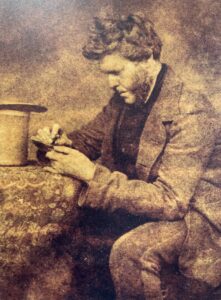
It starts with an armoured pterichthyodes, swimming through shallow waters 400 million years ago, scavenging for organic detritus, sweeping up decay.
Some time later, an amateur geologist cracks open a block of sandstone and discovers the clear outline of a fish, which is later confirmed as a Devonian fossil.
Then, a group of scientists and artists visit the Scottish town of Cromarty in search of stories. A museum has been created about the geologist, who became famous for his discoveries.
Before that, a group of fishermen spend several months in a rudimentary bothy, net fishing for salmon, which are sent to Spain and Italy.
Elsewhere, Afro-Caribbean slaves work cotton plantations in America, their lives and labour sustained by salted fish caught thousands of miles away.
Earlier, igneous rocks move in and displace sandstone, and glaciers carve out the landscape making mountains and valleys.
Later on, an Englishman sits in the converted attic space of an old brewery in Cromarty, writing words on his Apple computer.
At the same time, shoals of shimmering salmon head on towards the continental shelf where they will grow fat and find their way further north.
In the future, a whisky bottle, discarded by a pair of kayakers staying in a disused fishing station, becomes the start of an impromptu coral reef that continues to grow over the decades that follow, covering fifty square kilometres off the coast of the Black Isle.
Then, an Atlantic salmon returns to the River Feshie in the Cairngorms and thrashing her tail she makes a gravel basket for her eggs.
Previously, a man takes a train to the English city of Newcastle where he will spend a few days, before returning to his home in Washington state, with the North Pacific stretching out to the west.
Millions of years later, the individual components of a laptop break down and decompose. Other parts are resistant to these processes and form future fossils from the Anthropocene.
Then, a winter storm brings nutrients up from the deep ocean to the surface waters, where blooms of phytoplankton flow up the aquatic food chain, supporting zooplankton that are snapped up by migrating salmon.
Then someone blows up a waterfall to open up new migration routes.
Then 400,000 salmon eggs are gathered in a hatchery and re-placed upstream.
Then, two water bailiffs sit in a van for 10 hours, until they watch poachers removing salmon from their nets and move in for the arrest.
Then a visual artist, a musicologist, and several children arrive.
Then a pint of India Pale Ale is pulled.
Then, sand grains form, as minerals of quartz and feldspar are worn off other rocks and ground down. These are compacted and cemented together over tens of thousands of years and at some point, a fish dies, and sediment covers its body for tens of thousands more.
It ends as inconspicuously as it starts, as a salmonoid swims through deep waters 400,000 years from now, ingesting sand eel larvae, riding the current, seeking out the future.
